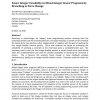Free Online Productivity Tools
i2Speak
i2Symbol
i2OCR
iTex2Img
iWeb2Print
iWeb2Shot
i2Type
iPdf2Split
iPdf2Merge
i2Bopomofo
i2Arabic
i2Style
i2Image
i2PDF
iLatex2Rtf
Sci2ools
COR
2011
2011
Faster integer-feasibility in mixed-integer linear programs by branching to force change
Branching in mixed-integer (or integer) linear programming requires choosing both the branching variable and the branching direction. This paper develops a number of new methods for making those two decisions either independently or together with the goal of reaching the first integer-feasible solution quickly. These new methods are based on estimating the probability of satisfying a constraint at the child node given a variable/direction pair. The surprising result is that the first integer-feasible solution is usually found much more quickly when the variable/direction pair with the smallest probability of satisfying the constraint is chosen. This is because this selection forces change in many candidate variables simultaneously, leading to an integer-feasible solution sooner. Extensive empirical results are given.
Applied Computing | Branching Direction | COR 2011 | Integer-feasible Solution | Smallest Probability |
| Added | 13 May 2011 |
| Updated | 13 May 2011 |
| Type | Journal |
| Year | 2011 |
| Where | COR |
| Authors | Jennifer Pryor, John W. Chinneck |
Comments (0)

